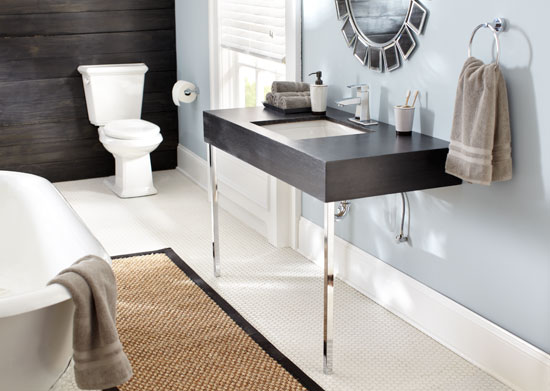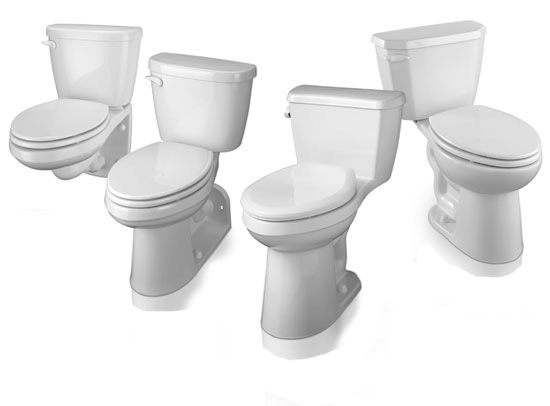Selecting Better Toilets by Design
LEED® by the U.S. Green Building Council
The green building movement in this country has given rise to quantifiable rating systems that seek to establish specific levels of achievement in the creation and performance of green buildings. The best known of these green building rating systems has been developed by the U.S. Green Building Council and known as the LEED® rating system. The LEED 2009 system is in place until the year 2015 which overlaps with LEED version 4 introduced late in 2013. Since buildings are currently being designed under both systems, it should be noted that credits may be earned somewhat differently for each when seeking certification. This family of green building rating systems also includes one specifically for homes updated in 2013 and referred to as LEED for Homes version 4.
LEED is a comprehensive rating system that addresses Water Efficiency as one of its fundamental categories in all building situations. In LEED v. 4, toilets are specifically addressed as part of the overall intent to reduce indoor water consumption. First there is a prerequisite that toilets use 20 percent less water than the code baseline of 1.6 gallons per flush. That prerequisite further states that “All newly installed toilets …that are eligible for labeling must be WaterSense labeled (or a local equivalent for projects outside the U.S.)”. Hence, in order to even consider LEED certification, HET / WaterSense labeled toilets are an automatic, entry level item at 1.28 gallons per flush performance. In order to earn actual points for indoor water conservation, the water consumption must be lower still. Depending on the particular LEED program used (i.e. New Construction, Schools, Core & Shell, etc.) between 1 to 7 points are available for these further reductions. Generally, each 5 percent of further reduction will earn one point such that 25 percent total reduction garners 1 point, 30 percent achieves 2 points and so forth. This can be achieved in part by using toilets that achieve higher efficiencies than WaterSense products (i.e. 1.1 gallon per flush models). Since the focus is on reducing potable water use, it can also be achieved in part by channeling “grey water” from sink and shower drains to be used for flushing toilets.

Photo courtesy of Gerber Plumbing Fixtures, LLC
LEED certification requires the prerequisite that all new toilets are WaterSense labeled High-Efficiency Toilets.
For LEED for homes, there is a choice within the Water Efficiency category to follow either a Performance Path option by using a computer-modeled level of water performance or a Prescriptive Path option by following a checklist of specific items. In some cases it is worth looking into both options and determining which produces the better results and higher potential rating.
Specifying Flush Toilets
When specifying and selecting the best toilet for a particular building or design application, it should be clear by now that there are choices and details to pay attention to. The Master Format section number commonly used is 22 41 13 for Residential Plumbing Fixtures and 22 42 13 for Commercial Plumbing Fixtures. Some of the relevant items to address in a standard 3-part specification format are highlighted as follows.
Part 1 General
When it comes to specifying the most appropriate toilets for a particular building, especially a green building, the first place to look at is testing certifications and labels. Calling for HET and WaterSense labeled toilets are likely a minimum requirement. It may be appropriate to call for MaP ratings as well, particularly if you are looking for a fixture with a rating of 1,000. If a handicapped accessible designation is also required that should be referenced.
Submittals will be similar to most plumbing products for information and confirmation of specification compliance. There may also be the need for coordination drawings or details with the rest of the plumbing system design. Other general specification items should include warranty requirements. Vitreous china commonly carries a limited lifetime warranty, pressure valves up to a 10-year warranty and 5 years for all else.
Part 2 Products and Options
Identifying the details of specific toilets including materials and options that are desired requires covering several items. If multiple product types are selected for a building, then obviously they each need to be specified and their locations identified on the drawings.

Photo courtesy of Gerber Plumbing Fixtures, LLC
When specifying toilets, it is important to consider the different options not only in shape and appearance but also in performance and water efficiency.
The basic size and configurations of the vitreous china tanks and bowls need to be identified as to round, elongated, or compact elongated. If a particular manufacturer’s style is required, that should also be spelled out. It is also important to identify the color of the vitreous china glaze. White is the common default color with an off-white also offered as standard by most manufacturers. There are other custom colors available as well that will vary by manufacturer.
Next to identify is the flush valve details including the required gallons per flush performance. If a compressed air valve is required that should be clearly called out with all other corresponding performance requirements. From there, the flush valve can be specified with particular materials or by types to suit the durability and usage frequency of the toilets.
Part 3 Installation
Installing toilets is generally straightforward but usually requires the skill of a plumbing subcontractor for best results. In the event field conditions dictate it, the plumbing subcontractor should have the flexibility and freedom to change the tank to suit the depth needed for a proper installation. In all cases, manufacturer’s recommendations should be followed for installation, cleaning, and testing.










